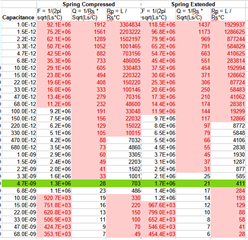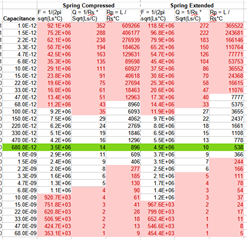Hello,
I have an application where I would like to do low power measurements of a spring's length using the LDC3114.
I have measured the the spring extended and compressed using an LCR meter and got the following measurements:
| Spring Extended | Measured at 1V, 125kHz | |
| Lp | 2.6606 | uH |
| Rp | 2.7786 | Ohms |
| Qp | 1.3297 | Q |
| Ls | 1.8037 | uH |
| Rs | 0.93459 | Ohms |
| Qs | 1.2126 | Q |
| Spring Compressed | Measured at 1V, 125kHz | |
| Lp | 3.4381 | uH |
| Rp | 6.2435 | Ohms |
| Qp | 2.3121 | Q |
| Ls | 2.9879 | uH |
| Rs | 0.9041 | Ohms |
| Qs | 2.0765 | Q |
These measurements violate the sensor parameters LDC3114 requires, namely the "5 <= Q <= 30" and "350 Ohms <= Rp <= 10k Ohms".
This generates the following questions:
- I realize these measurements were conducted at a lower frequency than the desired operating frequency of the LDC3114, are they of any use for tuning the sensor configuration?
- I understand additional inductance can be added in series with the sensor as per this blog (https://e2e.ti.com/blogs_/b/analogwire/posts/inductive-sensing-how-to-use-a-tiny-2mm-pcb-inductor-as-a-sensor),
is it possible to add additional resistance in series with the sensor to modify it's Q factor? - Any other tips for getting this spring working with the LDC3114? (i.e. selecting COM pin capacitors?)
Thanks,
Chris





